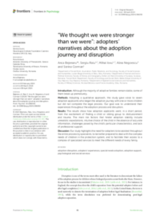Introduction:
Although the majority of adoptive families remain stable, some of them break up prematurely.
Research objectives:
The goal of this study was to understand the participants` experiences throughout the adoption and disruption process and the challenges they encountered in their journey with the child or siblings entrusted for adoption.
Specifically, our objectives sought to:
(1) explore the motivations to adopt a child from the HtAC list; (2) analyze how they appreciated their preparedness for the process; (3) identify the challenges the children’s characteristics posed and their ability to cope with them; (4) describe the experience with adoption specialists and support services, and (5) to capture how they felt about the adoption journey and disruption process.
Materials and methods:
The present study is part of a larger research project that focused on the resilience of the adoptive family in Romania. To capture resilience, within this project, we triangulated the ecosystem perspective and that of family development, as proposed by Walsh (2007). The ecosystemic perspective allowed us to study resilience as a multilevel interaction process between the adoptive family and other complex or challenging systems (Ungar, 2015), while the developmental perspective facilitated the understanding of adverse factors over time and gave coherence to the study.
The research project included both adopters who completed the process and currently have a stable adoption, as well as participants who interrupted this process. In the current study, only the latter were included.
The profile of participants:
Of the 41 participants in the study, seven met the following inclusion criteria: they had initiated the adoption procedure for a child/sibling group from the list of HtAC during 2018–2021, and they requested the revocation of the adoption before its legal completion. Six of the selected participants were female, and one participant was male. Among them, one adopter was unmarried, and six were married. The participants were approached individually, but in the case of a couple, both partners wanted to participate in the study and were accepted. Their responses were processed and reported separately. The parents’ ages ranged from 37 to 51, with a mean age of 41. All the participants in the study have completed higher education and have well-developed careers in different fields: two work in educational services, two in public administration, two offer professional and technical services, and one in financial services. The study refers to nine children. Four were placed alone, and the others in sibling groups of two and three. The children spent between four and 20 weeks with the adoptive family.
Methods:
Adopting a qualitative approach, this study gave voice to seven adoption applicants who began the adoption journey with one or more children but did not complete the legal process. Our goal was to understand their experiences throughout the adoption process and disruption.
Results:
The results show how adoption applicants went, in a short period, from the excitement of finding a child or sibling group to disillusionment and trauma. The main risk factors that hinder adoption stability include unrealistic expectations, intuitive choice of the child in the absence of accurate information, challenges posed by the child’s particular characteristics, and lack of professional support.
Discussion:
Our study highlights the need for adopters to be assisted throughout the entire process by specialists, to be better prepared to deal with the complex needs of children in the protection system, and to facilitate their access to a complex of specialized services to meet the different needs of every family.

